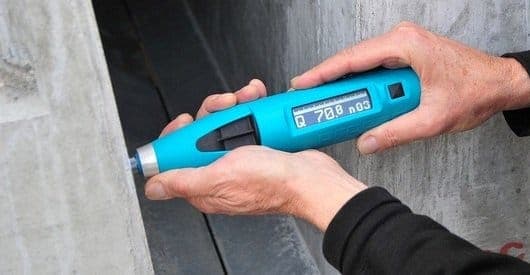
Rebound hammer test results are used to assess the surface hardness, and the test is only preliminary or complementary method to evaluate the concrete structure. Concrete testing thus by hardness methods is not considered to be a substitute for other well-established methods.

We have already discussed rebound hammer test procedure and its precaution while carrying out the test. We have also discussed the use of rebound hammer test and its limitations. Here we discuss the points which affect the rebound hammer test results.
The Point that Affects Rebound Hammer Test Results
Following are the point which affects the rebound hammer test results, which needs to be understood properly.
01. Concrete mix design characteristics
- Type of Cement
- Cement content
- Type of Coarse Aggregate
02. The angle of inclination of the direction of rebound hammer with reference to horizontal.
03. RCC structure member characteristics like type of cement used, age of concrete, type of surface, and location of reinforcement
- Mass
- Compaction of concrete
- Type of surface
- Age, rate of hardening and type of curing
- Surface carbonation
- Moisture Condition
- Stress state and temperature
Each of these may affect the rebound hammer test results. Furthermore,
04. The rebound hammer test results obtained by the test are not perfectly accurate and hence not conclusive.
05. They are suggestive only and are used for making the comparative study of different elements in one particular structure.
06. Rebound hammer has to be calibrated for the accuracy of the test results.
07. By referring some conventional table, the rebound hammer test result can be used to determine the strength of concrete.
08. 15 to 20% variation in the result is found due to many limitations of the test.
Hence we can conclude that rebound hammer test results do not give the accurate strength of concrete. It is only useful for repairs as the strength of different elements at different locations can be compared relatively. The different rebound number of a concrete laid in one batch at a time suggest concrete of varying property. Thus these rebound hammer test results are very useful for identifying hardness of surfaces than checking strength. Furthermore, use more reliable and proven methods like Ultrasonic test and core test for checking the compressive strength of the concrete structure.
The experienced engineers therefore first carry out rebound hammer test which is suggest comparatively stronger and weaker areas. The doubtful areas than can be tested with Ultrasonic pulse velocity test. The core test would become a must where even the ultrasonic tests suggest poor concrete. Thus the engineer has to use his common sense for carrying various tests in combinations and make the judgement before determining any strengthening proposals.
Also Read:
Non-Destructive Concrete Tests for Structure Strength
Penetration Resistance Test of Concrete Compressive Strength
In-situ Concrete Pull Out Test for Compressive Strength






























